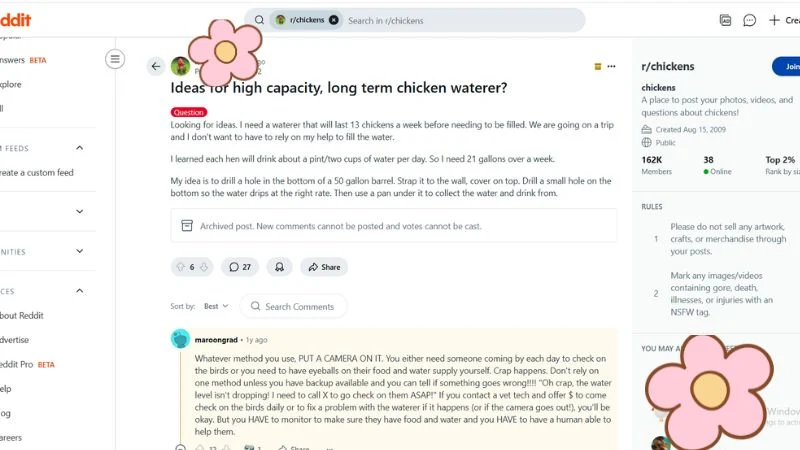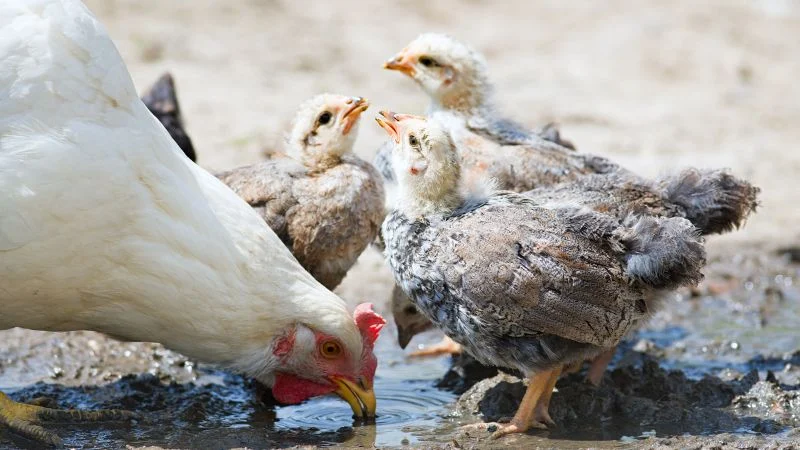I. One Reddit Post, 13 Hens, and the Case for a 5-Gallon Waterer
Right before writing this article, I happened to come across a Reddit post from a backyard chicken keeper. They had 13 hens and were getting ready to leave for a one-week vacation. Not wanting to bother their neighbors just to… refill water every day, they did some quick math: each chicken drinks about 1 pint of water per day. Their plan? Fill a 50-gallon barrel, hang it up high, and drill a small hole so the water would slowly drip into a pan for the chickens to drink from.

The post got a lot of responses from the community—ranging from simple DIY suggestions to high-tech automatic watering systems. And I also shared my advice:
“A 5 gallon chicken waterer is all you really need.”
Sound unreasonable?
So why just 5 gallons?
👉 The answer is right here in the article below.
II: Why a 5-Gallon Chicken Waterer Is the Smart Choice
Popular Types and How They Work
Back to that Reddit story. On paper, using a 50-gallon water barrel sounds smart: 13 hens, each drinking about 1 pint per day, over 7 days—you’re looking at around 90–100 pints total. And since 50 gallons equals roughly 400 pints, you’d think that’s more than enough. But in reality, it’s not that simple.
First, trying to control the water flow with just a tiny hole dripping into a pan? That’s asking for trouble. It could clog up (meaning your chickens won’t get enough to drink), or it could leak too fast and run dry before the week’s even over.
Second, the pan underneath isn’t reliable either. Chickens can easily knock it over, poop in it, or kick dirt into it—making the water undrinkable.
Third, even if everything goes “perfectly” and there’s still water left at the end of the week, stagnant water sitting in an open pan becomes a magnet for bacteria, droppings, and dust. Not great.
Long story short, when that Reddit user came back from vacation, the 50-gallon DIY setup had been abandoned. Leaking water, tipped-over pans, and dirty water made it a no-go.
That’s exactly why I recommend skipping the giant, hard-to-manage setup. A compact, well-designed 5-gallon chicken waterer is a much smarter, more practical solution for most backyard chicken keepers.
1. What Is a 5 Gallon Chicken Waterer?
As the name suggests, it’s a water container that holds around 5 gallons—enough to keep a small flock hydrated for a few days. These waterers can be made from plastic or metal and either sit on the ground or hang, depending on the design.
2. Common Types of 5-Gallon Chicken Waterers
If you’ve already read my article How to Choose the Best Chicken Waterer for Your Coop, you probably have a good overview of the pros and cons of different types of waterers. In this post, I’ll narrow the focus and specifically categorize 5-gallon chicken waterers based on their water delivery mechanism. This feature directly impacts the durability, convenience, and ability to keep your flock’s water clean.
Here are the three most popular types:
a) Gravity-Fed Waterers
This is the classic, most widely available design. It usually features a large plastic or metal container turned upside down into a base tray.
Water flows down naturally using air pressure: as chickens drink and the water level in the tray drops, air enters the container through a small vent, letting more water flow out. Once the tray fills up and blocks the vent, the water stops flowing.
🔧 Pros: Simple, no training needed, easy to set up, budget-friendly.
⚠️ Cons: Tray water gets dirty quickly if placed directly on the ground or outdoors without cover.
b) Nipple Waterers
This design attaches drinking nipples to a 5-gallon container—either on the bottom or sides. Chickens peck the nipples, and water is released in small drops. It stops immediately when they stop pecking.
🔧 Pros: Keeps water super clean, reduces waste, ideal for hanging setups.
⚠️ Cons: Chickens need time to learn how to use it, and the nipples can jam if not maintained.
c) Cup Waterers
This one’s pretty clever:
• When the cup is empty, it’s light—triggering the valve to open and fill it.
• As the cup fills, it gets heavier—causing the valve to shut.
• As chickens drink and the level drops, the valve opens again to refill.
🔧 Pros: Delivers just the right amount of water, limits spills, stays relatively clean.
⚠️ Cons: Requires occasional cleaning, and the cups may break or fall off over time.
Each of these options has its trade-offs, but they all share one major advantage: automatic water control. Water only comes out when needed—so there’s less waste, less mess, and a lower chance your flock goes thirsty.
Sounds like a 5-gallon waterer might be the perfect fix, right?
But is 5 gallons really enough to last a whole week while you’re away?
👉 That answer—and a smarter solution—comes next…
III. How to Keep Your 5-Gallon Waterer from Running Dry While You’re Away
This is the fun part—how to automate your 5-gallon chicken waterer so your flock always has fresh water, even when you’re not home to refill it every day.
The solution is surprisingly simple: connect the waterer to a garden hose and install a float valve. When the water level drops, the float drops too, opening the valve and letting water in. As the water rises, the float lifts and shuts the valve automatically. The system repeats this cycle to keep the reservoir full at all times—even if you’re gone for several days.

But here’s the catch: not every 5-gallon waterer works well with this kind of setup. Out of the three types we covered—gravity-fed, nipple, and cup-style—only nipple and cup waterers are compatible with automatic refilling. Gravity waterers rely on sealed upside-down tanks, which don’t allow for top-fill or external water input.
Here’s a simple flow diagram of the setup:
Water supply → 5-gallon container (with float valve) → Water outlets (nipple or cup drinkers)
Once everything’s connected, just turn on the hose—and the system takes care of the rest!
IV. How to Choose the Right 5-Gallon Waterer for Your Flock
Now that you know how the auto-refill system works, it’s time to pick the right type of waterer to make the most of it. Below are three common approaches:
1. Buy a Pre-Assembled Kit – Quick and Convenient

If you’re short on time or not big on DIY, pre-built 5-gallon watering systems are a great choice. Just set it up in the coop and you’re good to go. Most of these kits include everything you need—tank, float valve, and drinker heads—and they’re super easy to maintain.
👉 Check out some ready-to-use 5-gallon automatic waterer kits on Amazon:
🔗 Pre-built kits with float valves and drinkers
Pro tip: Pick a size that matches your flock. You can also buy extra drinker nipples or cups to avoid crowding when your chickens line up to drink.
2. Build Your Own DIY System – Flexible and Cost-Effective
If you enjoy hands-on projects or want something more customized, building your own system is both fun and budget-friendly. Here’s what you’ll need: a 5-gallon bucket, an automatic float valve, water hose/tubing, connectors, and your choice of drinker heads (nipples or cups).
👉 Here are a few recommended DIY parts:
• 🔗 Automatic float valve
• 🔗 Chicken water nipples
• 🔗 Auto-refill drinking cups
Example: For 13 chickens, one 5-gallon bucket with 4–5 drinkers works well. If you expand to 20 birds later, consider adding a second bucket to spread the load. For smaller flocks, a 2-gallon tank can work—but keep the tips below in mind.
3. Real-Life Tips from Experience
• Avoid using 2-gallon buckets, even for small flocks: they often lack enough water pressure for float valves to function well and aren’t practical long-term. A 5-gallon bucket without a float is still better.
• Two 5-gallon buckets are better than one 10-gallon: easier to clean, more flexible placement, and gives you a backup if one has issues.
• DIY setups are cheaper and more adaptable. You can repurpose containers and just swap out the bucket if it breaks—no need to rebuild the whole system.
• Personally, I prefer cup-style drinkers—they’re easy to monitor and clean.
V. Important Tips for Using a 5 Gallon Chicken Waterer
While a 5-gallon waterer with an auto-refill system is a smart and efficient solution, to keep it working well and lasting longer, here are a few key things to keep in mind:
1. Place the waterer on a raised, level, and shaded area
– Raise the waterer at least 6–8 inches (15–20 cm) off the ground to prevent dirt, droppings, or debris from getting kicked into it.
– If using a hanging waterer, make sure the hanger is secure and the drinker is at the right height—level with the chickens’ heads when standing.
– Ideally, place the waterer in a shaded or roofed area so the water doesn’t overheat in the summer sun (especially important for plastic containers).
2. Clean regularly to keep the water fresh
– Even with nipples or cup-style waterers—which generally keep water cleaner—it’s best to clean the whole unit every 5–7 days to prevent algae and bacteria buildup inside the container.
– For tray-style waterers, clean more often—every 2–3 days—depending on your coop conditions.
3. Inspect the float valve and drinker heads regularly
– Nipple drinkers can get clogged with dust or calcium buildup from hard water. Check each nipple or cup at least once a week to ensure proper flow.
– For float valve systems, make sure the float rises and drops smoothly without getting stuck.
4. Use clean water—free from sediment or chlorine
– Tap water in some areas may contain chlorine or impurities, which aren’t ideal for long-term use.
– Consider using a simple filter or let the water sit overnight before connecting it to the waterer if you’re concerned about water quality.
5. Match drinker heads to your flock size
– General rule: 1 drinker nipple or cup per 5–6 chickens to prevent crowding.
– For larger flocks, spread multiple drinker heads across different spots—or use multiple smaller waterers instead of one large one.
VI. Final Thoughts: Is a 5 Gallon Waterer Right for Your Backyard Flock?
If you’re keeping a backyard flock of 5–15 chickens, a 5-gallon waterer is one of the most ideal solutions:
✅ Easy to buy or DIY
✅ Can be upgraded to auto-refill
✅ Keeps water clean and consistent
✅ Doesn’t take up too much space
That said, the success of your watering system doesn’t just depend on size or design—it all comes down to how you set it up and maintain it. With the right combination of waterer type, smart layout, and regular upkeep, you can let your flock “handle hydration” on their own—even if you’re away from home for 5–7 days.
👉 Are you using a 5-gallon system or something else? Got a clever tip to share?
Feel free to drop a comment or share your experience—I’m always happy to update this guide with helpful input from the backyard chicken community!



